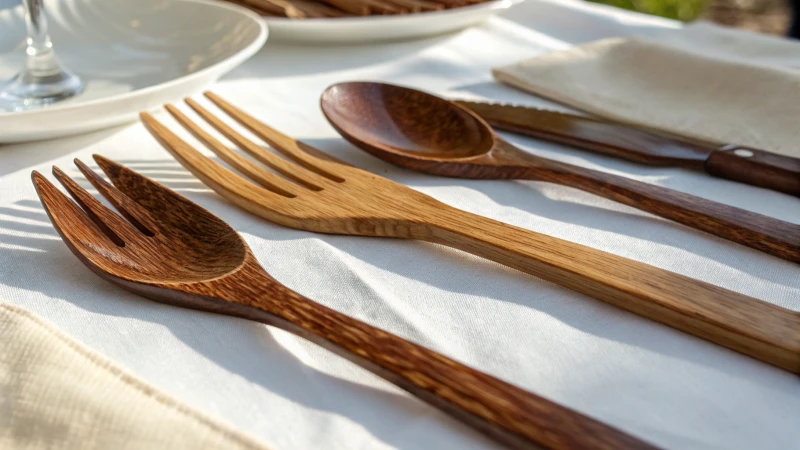
When I first switched to disposable wooden cutlery, hygiene was my main concern.
Natural varnishes and antimicrobial coatings on disposable wooden cutlery create a protective barrier that reduces bacterial contamination. This makes them safer for food service by inhibiting bacterial growth, ensuring a more hygienic experience.
I remember standing in the aisle, eyeing those neatly packed wooden forks and spoons, questioning their cleanliness compared to my trusted plastic ones. But then, I discovered that these coatings aren't just for show. They work behind the scenes to keep things safe and clean. Learning about how these treatments work, from application methods to their added benefits, opened my eyes to how much they matter. It's not just about being eco-friendly; it's about making sure every meal is served safely, without a side of germs.
Natural varnishes reduce bacterial contamination.True
Natural varnishes create a barrier that inhibits bacterial growth.
Antimicrobial coatings are ineffective on wooden cutlery.False
Antimicrobial coatings inhibit bacterial growth, enhancing hygiene.
What Are Natural Varnishes and How Do They Work?
Imagine finding a way to protect and beautify wood using nothing but natural ingredients. Sounds like magic, right?
Natural varnishes, crafted from plant oils and resins, create a breathable protective film over wood, enhancing its beauty while shielding it from moisture and wear.
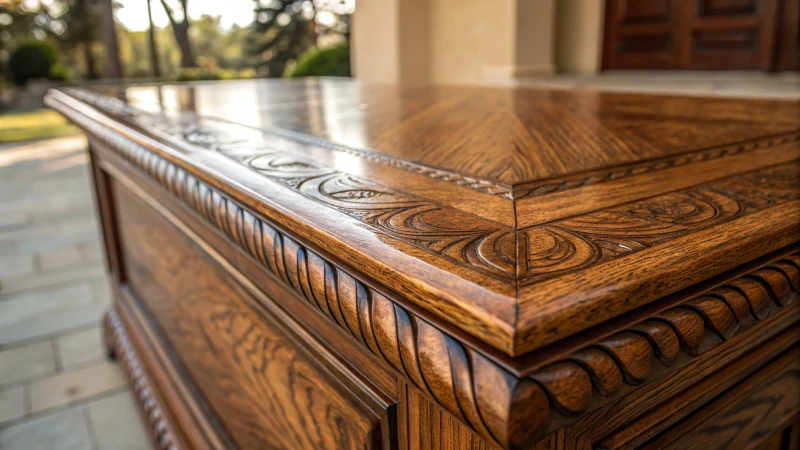
The Composition of Natural Varnishes
I remember the first time I discovered the magic of natural varnishes. It was during a home renovation project, where I was determined to use only eco-friendly materials. The idea of using a finish made from the simplest elements of nature—like linseed oil or tung oil mixed with resins such as dammar or copal—captivated me. These ingredients are not just random picks; they are chosen for their incredible ability to protect and highlight the natural beauty of wood.
- Linseed Oil: This oil, derived from flax seeds, is like a miracle worker. It seeps deep into the wood, bringing out its stunning grain patterns and forming a strong barrier against environmental changes.
- Tung Oil: Imagine a finish that dries quickly and forms a water-resistant shield—perfect for furniture that's meant to brave the outdoors.
| Oil Type | Properties | Best Used For |
|---|---|---|
| Linseed | Deep penetration | Indoor furniture and flooring |
| Tung | Water-resistant | Outdoor furniture and decking |
How Do Natural Varnishes Function?
Applying natural varnish is like watching a chemistry experiment unfold. As I carefully brushed it over my wooden coffee table, I could almost see the molecules knitting together, forming a protective web. This process, known as polymerization, not only defends the wood from scratches and moisture but also allows it to breathe and flex with temperature changes.
Application Techniques
Patience is truly a virtue here. I learned this firsthand when applying natural varnish involves meticulous steps:
- Surface Preparation: Cleaning and sanding the wood felt almost meditative, creating a perfect canvas for the varnish.
- Application: I gently applied thin layers with a soft cloth, letting each coat dry thoroughly before moving on to the next.
- Finishing Touches: Sanding lightly between coats made all the difference in achieving that smooth, polished look.
Every step felt like adding another layer of love and care to my wooden pieces.
Benefits Over Synthetic Options
Why go natural? For me, it was about peace of mind knowing I was choosing an eco-friendly path. Natural varnishes are made from renewable resources, reducing environmental impact. They let the wood breathe, which prevents issues like warping or mold—no small feat for any project! Plus, the aesthetic transformation is undeniable; the finish enhances wood's natural charm with a rich glow.
For those eager to delve deeper into these sustainable choices, there's a wealth of knowledge out there on eco-friendly finishes1. It’s about making informed decisions that help us tread lightly on our planet.
Linseed oil is water-resistant.False
Linseed oil penetrates wood but isn't inherently water-resistant like tung oil.
Natural varnishes allow wood to breathe.True
They prevent moisture buildup by allowing air exchange, reducing warping risk.
How Effective Are Antimicrobial Coatings in Reducing Bacteria?
Ever wondered if antimicrobial coatings really make a difference in keeping germs at bay? Let’s dive into their world and see if they live up to the hype.
Antimicrobial coatings can effectively cut down bacteria on surfaces, especially when used alongside regular cleaning. They're a powerful tool for maintaining hygiene and safety in various settings.
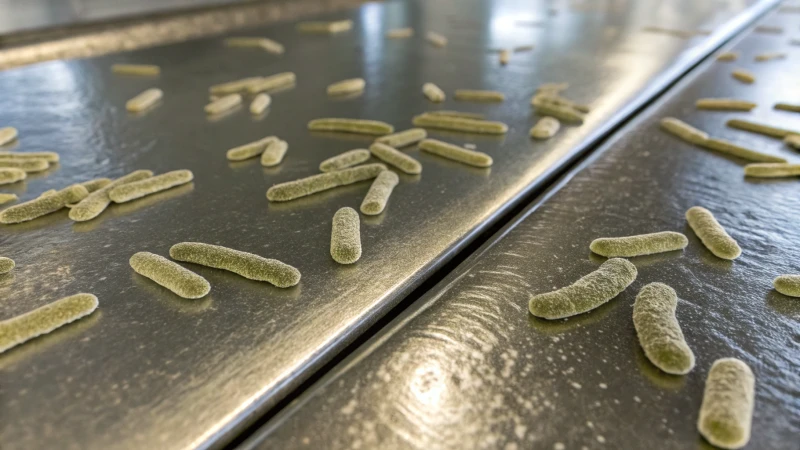
The Science Behind Antimicrobial Coatings
Antimicrobial coatings are designed to protect surfaces from bacterial growth by releasing or activating agents that kill or inhibit microbes. I remember the first time I heard about antimicrobial coatings, I was skeptical. But after doing some research, I found out these coatings actually work by releasing agents like silver ions or copper, which have been known for their germ-killing properties for centuries. Each agent has its own way of dealing with bacteria. Silver, for example, disrupts bacteria's cellular processes, while copper damages their cell membranes. It's fascinating to think that these metals, which have been around forever, are still so relevant today.
Types of Antimicrobial Coatings
| Coating Type | Key Component | Common Uses |
|---|---|---|
| Silver-based | Silver ions | Medical devices, textiles |
| Copper-based | Copper ions | High-touch surfaces, hospital |
| Zinc-based | Zinc oxide | Paints, personal care products |
I once had a conversation with a hospital supply manager who swore by copper-based coatings for high-touch surfaces like door handles. She mentioned that after they started using these coatings, they noticed a significant drop in infection rates. It's incredible to hear firsthand how these technologies are making a real difference.
Effectiveness Across Different Surfaces
The effectiveness can vary greatly depending on the surface material. Non-porous surfaces like metal or plastic tend to show better results with these coatings. For example, copper-based coatings are particularly effective in reducing bacteria on high-touch areas such as doorknobs and railings in public spaces. I found this out while helping a friend choose materials for a new clinic—they opted for copper-coated railings which proved more effective than expected. This is why understanding the environment2 where these coatings are applied is crucial.
Limitations of Antimicrobial Coatings
But here's the thing—these coatings aren't magic. They need to be part of a broader hygiene strategy. Over-relying on them without proper cleaning can actually backfire, leading to antimicrobial resistance3. I learned this the hard way during a kitchen renovation project where we overestimated their capacity. Regular cleaning is still key.
Understanding these limitations helps organizations make informed decisions about where and how to implement these coatings effectively.
Real-World Applications and Case Studies
I've seen hospitals use these coatings on everything from bedrails to surgical instruments, with impressive results. In a recent study4, hospitals reported a significant reduction in bacteria-related infections after applying antimicrobial paints and surfaces.
Similarly, public transport systems have also jumped on board; New York City's buses and trains have implemented copper-infused surfaces to great effect.
These real-world examples show how strategic use of antimicrobial coatings can support hygiene efforts without replacing basic cleaning practices. By examining these real-world applications, we can assess how antimicrobial coatings might benefit various industries and environments. A comprehensive approach ensures these coatings fulfill their potential without overestimating their capabilities.
Silver-based coatings are effective on medical devices.True
Silver ions disrupt bacterial cell membranes, reducing growth effectively.
Antimicrobial coatings replace the need for cleaning.False
They complement cleaning but cannot substitute regular hygiene practices.
What Are the Potential Downsides of Using Treated Wooden Cutlery?
Treated wooden cutlery seems like the perfect eco-friendly choice, but is there more beneath the surface? Join me as I delve into the potential pitfalls that might be lurking in this sustainable swap.
Treated wooden cutlery can raise concerns due to possible chemical exposure from coatings, durability issues, and environmental impacts. Being aware of these factors can guide informed decisions when choosing sustainable dining options.
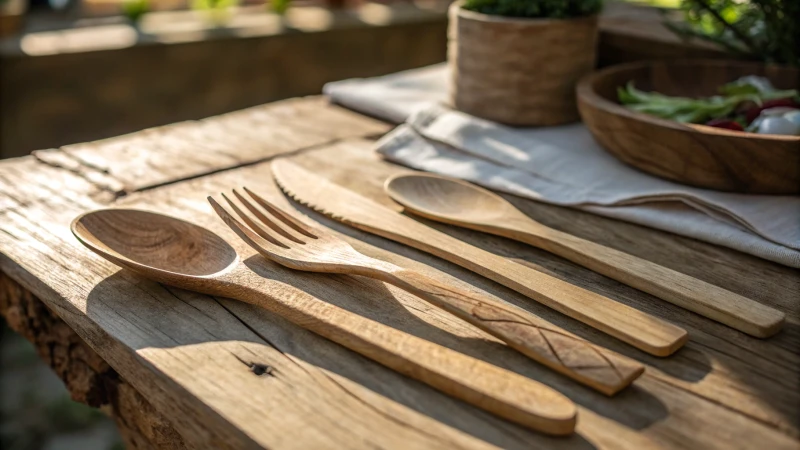
Health Implications of Treated Wooden Cutlery
I remember the first time I switched to treated wooden cutlery—it felt like a small victory for the planet. But then I stumbled across some information that made me pause. The potential chemical exposure5 from surface treatments like varnishes or antimicrobial coatings was a real eye-opener. While these treatments are designed to enhance hygiene, ensuring that coatings are food-safe is crucial. The idea of chemical leaching, especially when exposed to heat or moisture, kept nagging at me.
| Pros | Cons |
|---|---|
| Enhanced hygiene | Possible chemical exposure |
| Long-lasting finish | Potential leaching issues |
Durability and Usability Concerns
Over time, I've noticed that treated wooden cutlery often boasts better durability compared to its untreated counterparts. It's reassuring to think that they're less likely to warp or splinter. However, there are usability drawbacks6—brittleness being a significant one. If these utensils aren't maintained properly, especially with frequent washing or exposure to temperature changes, they can become fragile.
- Durability: Treatments can make cutlery less prone to breakage.
- Usability: Risk of brittleness if not properly maintained.
Environmental Impact Considerations
Switching from plastic to wood felt like a giant leap towards sustainability for me. Yet, the environmental impact of the treatments used on these utensils still concerned me. Some coatings might not be biodegradable, potentially affecting the overall eco-friendliness7 of the product.
- Biodegradability: Check for eco-friendly coatings.
- Sustainability: Balance between treatment benefits and environmental cost.
| Aspect | Impact |
|---|---|
| Biodegradability | Depends on coating used |
| Sustainability | Varies with manufacturing process |
Treated wooden cutlery may leach chemicals when heated.True
Chemical leaching can occur when treated cutlery is exposed to heat or moisture.
All treated wooden cutlery is biodegradable.False
Some treatments use non-biodegradable coatings, affecting eco-friendliness.
How Do Natural Varnishes and Antimicrobial Coatings Compare to Traditional Methods?
Ever wondered if there’s a better way to keep your wooden cutlery clean and safe? Let’s dive into how new treatments are changing the game for eco-friendly dining essentials.
Natural varnishes and antimicrobial coatings provide superior antibacterial protection for wooden cutlery compared to traditional methods. These innovative solutions significantly reduce bacterial contamination, enhancing hygiene and appealing to environmentally-conscious consumers.
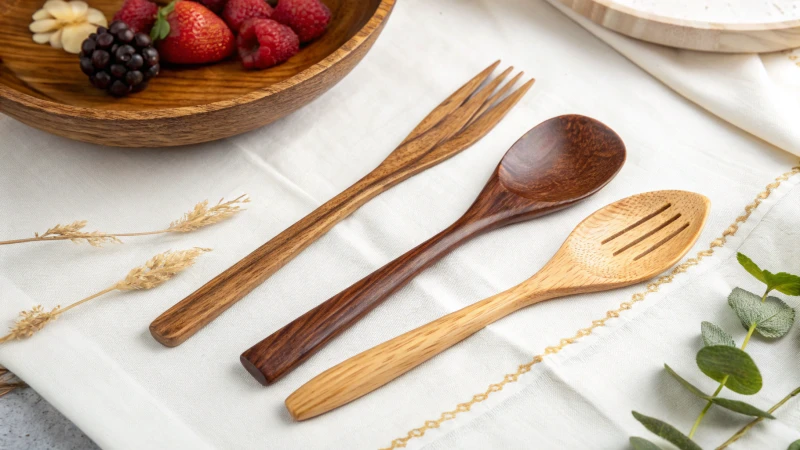
Exploring Natural Varnishes and Antimicrobial Coatings
I remember the first time I saw those beautiful wooden forks at a friend's picnic. They looked so elegant, yet I wondered about their safety, especially in terms of hygiene. That's when I discovered natural varnishes and antimicrobial coatings. These aren't just fancy buzzwords; they're game-changers for keeping wooden cutlery not just beautiful, but also clean.
Let's break it down:
| Treatment Type | Mechanism | Benefits |
|---|---|---|
| Natural Varnish | Seals surface, preventing | Eco-friendly, enhances wood durability |
| bacterial growth | ||
| Antimicrobial Coating | Contains agents that inhibit | Reduces bacteria, prolongs cutlery lifespan |
| microbial activity |
While traditional methods often rely on synthetic chemicals, these natural options focus on sustainability. I once met a craftsman who made varnishes from plant-based ingredients. He was so passionate about his work, knowing his products were not only biodegradable but also non-toxic. This aligns perfectly with the growing demand for eco-friendly products8 in industries like hospitality.
Comparative Effectiveness
When I compare these treatments to traditional methods, a few things stand out:
- Cost: Sure, traditional methods might seem cheaper at first glance. But when you consider how often they need replacing, those costs add up.
- Environmental Impact: Natural treatments help reduce our carbon footprint—something that’s becoming more crucial for businesses aiming for sustainability9.
- Consumer Appeal: More people are choosing products that support a green lifestyle. By opting for natural treatments, businesses can boost their brand image and attract eco-conscious customers.
Industry-Specific Applications
Each industry has its own set of priorities. Take healthcare, for instance; they need to meet strict hygiene standards, and antimicrobial coatings provide that extra layer of safety. On the other hand, in the hospitality sector, it’s all about aesthetics and durability. Natural varnishes not only keep cutlery looking pristine but also ensure diners' safety.
I've seen firsthand how each industry needs to weigh these factors carefully to ensure that the chosen method meets both practical and ethical standards. Curious about how these treatments fit into broader trends? Explore how industries are weaving these innovative solutions into their supply chains10 and shaping the future of product development.
Natural varnishes are biodegradable and non-toxic.True
Derived from plant-based ingredients, they align with eco-friendly demands.
Traditional methods are more cost-effective long-term.False
Initial costs may be lower, but frequent replacements increase expenses.
Conclusion
Natural varnishes and antimicrobial coatings enhance the hygiene of disposable wooden cutlery by reducing bacterial contamination, ensuring safer food service while promoting eco-friendly practices.
-
Explore the environmental advantages of using eco-friendly varnishes over synthetic options. ↩
-
Discover how different environments impact the performance of antimicrobial coatings. ↩
-
Explore the potential for antimicrobial resistance due to overuse of coatings. ↩
-
Review real-world data on how these coatings reduce infection rates in hospitals. ↩
-
Learn about the safety standards for coatings used on wooden cutlery to ensure they're non-toxic and food-safe. ↩
-
Understand the common usability concerns related to treated wooden cutlery, such as brittleness or maintenance challenges. ↩
-
Discover how the treatments on wooden cutlery impact their biodegradability and overall environmental footprint. ↩
-
Understand the environmental benefits of choosing eco-friendly wooden cutlery over traditional plastic options. ↩
-
Learn why sustainability is becoming a critical factor in the hospitality industry's product choices. ↩
-
Discover how antimicrobial coatings are revolutionizing healthcare supply chains and improving hygiene standards. ↩

